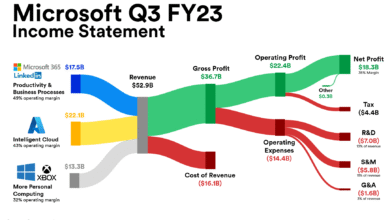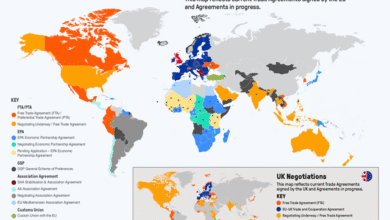De Minimis Trade Loophole: Trump Signs New Executive Order

The de minimis trade loophole has been a pivotal factor in the booming success of Chinese e-commerce giants like Temu and Shein in the United States. Recently, President Donald Trump signed an executive order that effectively closes this loophole, which has allowed shipments valued under $800 to enter the U.S. duty-free. As a result of this rule change, imported goods will now face adjusted import duties, which could rise to as much as $50 per item by June. This shift aims to address rising concerns over the volume of low-documented shipments flooding the market, amid ongoing debates concerning U.S. customs regulations and possible counterfeit products. With the impending import duties changes, the landscape of trade between China and the U.S. is poised for a significant evolution, impacting consumers and retailers alike.
Often referred to as the threshold exemption, the de minimis trade loophole has facilitated a wave of inexpensive product entries from abroad, primarily benefiting online platforms from Asia. As new tariffs roll out following a notable executive decision, U.S. e-commerce frameworks are set to undergo drastic adjustments. This potential overhaul comes as more consumers turn to affordable retailers, underscoring the importance of transparency and safety in the import process. The increased scrutiny surrounding e-commerce imports, particularly with regard to cheap goods from Chinese sellers, highlights a growing need for robust U.S. customs oversight. In light of these developments, both domestic retailers and international sellers must navigate the shifting terrain of import duties and compliance regulations with vigilance.
The Impact of Trump’s Executive Order on E-commerce
President Donald Trump’s recent executive order to close the de minimis trade loophole marks a significant shift in U.S. customs regulations regarding e-commerce. This order, effective May 2, aims to regulate the influx of low-cost goods imported from countries like China through platforms such as Temu and Shein. With the previous rule allowing shipments valued under $800 to enter duty-free, the loophole has facilitated remarkable growth for these Chinese e-commerce giants in the U.S. market, raising concerns over fair competition and market integrity.
As part of the executive order, customs regulations will now impose new duties on goods that qualify under the de minimis rule. Starting with a base rate of 30% of the value or $25 per item, this is set to rise to $50 per item in June, which could result in increased prices for consumers who shop on these platforms. The Trump administration’s objective is to create a level playing field for U.S. retailers while ensuring that imported goods meet safety and legal standards.
Understanding the De Minimis Trade Loophole
The de minimis trade loophole, which permits shipments below $800 to bypass duties, has been a double-edged sword for American consumers and local businesses. While it has allowed for cheaper access to a variety of products, it has also resulted in a substantial increase in the volume of cheap imports that pose potential risks. More than 1.3 billion de minimis shipments were processed by U.S. Customs and Border Protection in 2024, demonstrating the loophole’s extensive use and dependence in the e-commerce sector.
Critics argue that the de minimis structure undermines U.S. manufacturers and creates an environment ripe for fraud and safety violations. The ease of importing goods under this loophole has led to an influx of items with little to no oversight, making it challenging for customs officials to inspect shipments for compliance with safety regulations. Closing this loophole aims to curb these practices while enhancing oversight at U.S. borders.
The Growth of Temu and Shein Amid Regulatory Changes
Companies like Temu and Shein have seen explosive growth in the U.S. market, directly benefitting from the leniency provided by the de minimis loophole. With a focus on delivering low-cost fashion to American consumers, these platforms have capitalized on the absence of significant import duties, allowing them to offer competitive pricing. The implementation of the new tariffs and stricter customs regulations could challenge their current business models, forcing them to rethink their shipping strategies and pricing structures.
In light of the upcoming changes, Temu has taken proactive measures by consolidating its U.S. operations and onboarding local sellers. This shift aims to enhance their delivery speed and efficiency while navigating the complexities of new import duties. On the other hand, Shein is expanding its operational footprint by opening distribution centers across the country, positioning itself to adapt to the changing regulatory landscape swiftly.
Navigating U.S. Customs Regulations Post-Order
With Trump’s executive order in effect, businesses and consumers alike must navigate a new set of customs regulations that dramatically alter the landscape of e-commerce. The increase in duty rates for goods previously exempt from tariffs is expected to impact consumer habits, leading many to reconsider their reliance on platforms like Temu and Shein for inexpensive imports. Retailers will need to strategize accordingly to maintain competitiveness, especially with the potential for higher prices as duties come into play.
Moreover, the execution of these regulations may lead to longer processing times and more rigorous inspections at U.S. borders. As import duties change, businesses will find it essential to understand the implications these new rules hold for their supply chains and cost structures. It will be imperative for companies to stay informed about evolving customs policies to adapt quickly and efficiently.
Future Implications of Tariff Changes for E-commerce
As the landscape for e-commerce continues to evolve with the adjustment of tariffs, companies operating in this sector need to prepare for potential shifts in consumer behavior. The additional costs imposed by increased import duties could lead consumers to seek more domestic products, thereby pressuring Chinese e-commerce giants to invest more locally to remain relevant. This could result in a notable shift in sourcing strategies, affecting how brands approach their international sales.
Furthermore, the anticipated changes may spur a wave of innovation within the U.S. to establish competitive edge. As retailers grapple with the new operational realities, they may turn to technology-driven solutions to streamline logistics, enhance customer experience, and improve product quality. This adaptation could redefine the e-commerce industry in the U.S., leading to a potentially healthier marketplace where both consumers and local businesses thrive.
Concerns About Counterfeit Goods and Safety Standards
One of the primary concerns stemming from the de minimis trade loophole has been the influx of counterfeit and unsafe products into the American market, especially from Chinese e-commerce entities. With minimal documentation required for low-value shipments, it has become increasingly difficult for customs agents to monitor the legitimacy and safety of goods entering the U.S. This underscores the necessity of regulations that can adequately address these risks while maintaining consumer access to affordable options.
The Trump administration’s decision to close this loophole aims not only to improve oversight but also to safeguard U.S. consumers from potentially dangerous products. By implementing stricter customs regulations and duties, the government is taking steps to ensure that all imported goods meet the necessary safety standards. This shift could significantly enhance product reliability, fostering greater consumer trust in e-commerce overall.
Adapting to New Competitive Landscapes
In response to the regulatory changes, American retailers will need to innovate and adapt to remain competitive against both established brands and new entrants like Temu and Shein. The increased duties on imports may prompt U.S. companies to look inward, exploring domestic production options and supply chain efficiencies to mitigate potential cost increases. Those who can effectively pivot may find new opportunities to capture market share.
Furthermore, as U.S. customs regulations evolve, retailers must adjust their marketing strategies to highlight the value and quality of domestically sourced products. Consumer education will be key in communicating the benefits of shopping local versus relying on inexpensive imports. This proactive approach could not only help domestic businesses thrive but also stabilize the market as broader trends emerge in the wake of these changes.
The Role of U.S. Customs in Trade Dynamics
U.S. Customs and Border Protection plays a crucial role in shaping the dynamics of trade between the U.S. and countries like China, especially with the recent regulatory changes stemming from Trump’s executive order. By enforcing new duties and regulations, Customs is tasked with ensuring compliance while addressing the potential risks associated with increased imports. The agency will need to strike a balance between facilitating trade and protecting U.S. consumers and businesses from harmful practices.
As customs officials adapt to the higher volume of shipments facing new scrutiny, the efficiency of processing and inspections will become increasingly vital. The outcomes of these changes may influence trade policies and relations between nations moving forward, as countries assess how to respond to U.S. regulatory frameworks. The future of international commerce will largely depend on the ability of customs agencies to enforce these changes effectively without stifling legitimate trade.
Looking Ahead: E-commerce in a Post-De Minimis World
The closure of the de minimis trade loophole heralds a transition for e-commerce as it adjusts to comply with new customs regulations. U.S. retailers and consumers may experience a ripple effect as they navigate through the updated marketplace. As companies reassess their logistics and delivery timelines, consumers should stay informed on how these changes can affect pricing and availability of goods.
Looking ahead, it will be interesting to observe how companies like Temu and Shein adapt their strategies to remain competitive in a less forgiving regulatory environment. Their ability to restructure operations while offering affordable products will determine whether they can maintain their growth trajectory amidst the looming presence of new import duties. The landscape will undoubtedly change, leading to a redefined e-commerce ecosystem that emphasizes compliance and quality over merely price-driven sales.
Frequently Asked Questions
What is the de minimis trade loophole and how does it relate to U.S. customs regulations?
The de minimis trade loophole allows shipments valued under $800 to enter the U.S. without incurring customs duties. This exemption has been pivotal for Chinese e-commerce companies like Temu and Shein, facilitating their rapid growth in the U.S. market by enabling low-cost goods to bypass tariffs.
How is the Trump executive order affecting the de minimis trade loophole?
President Trump’s executive order aims to end the de minimis trade loophole, effective May 2, introducing new duties on qualifying goods. Under the new regulations, items that previously benefitted from this exemption may incur duties of 30% of their value or $25 per item, increasing to $50 per item in June.
What changes can consumers expect from the ending of the de minimis trade loophole?
With the de minimis trade loophole ending, consumers may experience higher prices on goods from Chinese e-commerce platforms like Temu and Shein due to new import duties. This could lead to a shift in purchasing habits as consumers begin to factor in these additional costs.
Why are Chinese e-commerce companies like Temu and Shein concerned about the ending of the de minimis loophole?
Chinese e-commerce companies like Temu and Shein have thrived under the de minimis trade loophole, which allowed them to deliver low-cost products to U.S. consumers without duties. The ending of this loophole may reduce their competitive edge and affect their sales due to the introduction of new duties.
What implications does the de minimis trade loophole have for the import duties of goods?
The ending of the de minimis trade loophole, as enforced by Trump’s executive order, will impose new import duties on low-value goods. Items valued under the set threshold will now face a duty of 30% or $25, creating potential complications for retailers and consumers alike.
How does the de minimis trade loophole impact competition for U.S. retailers?
The de minimis trade loophole has provided an unfair advantage to foreign e-commerce companies, particularly those from China, like Temu and Shein. With its closure, U.S. retailers may face a more level playing field as they will no longer be competing with substantial volumes of low-duty imports.
What are the potential drawbacks of the de minimis trade loophole closure for U.S. consumers?
The closure of the de minimis trade loophole may lead to increased prices for consumers shopping from Chinese e-commerce platforms, resulting in higher costs for goods they previously bought at lower prices. Additionally, delays in shipments could arise as the new customs regulations take effect.
How has the surge in de minimis shipments affected U.S. customs operations?
The U.S. customs operations have seen a significant increase in de minimis shipments, processing over 1.3 billion deliveries in 2024 alone. This surge raised concerns about inadequate documentation and the challenges of inspecting goods, prompting calls for reform of the loophole.
| Key Point | Details |
|---|---|
| Ending of the de minimis trade loophole | President Trump signed an executive order to end it effective May 2. |
| Temporary suspension | Initially suspended in February, but cancellation was delayed due to adaptation issues. |
| Effects on e-commerce | The loophole has aided Chinese companies like Temu and Shein, which saw significant growth. |
| New duty rates | Goods will incur a duty of $25 per item or 30% of their value, increasing to $50 on June 1. |
| Shipments under the loophole | Shipments valued under $800 could enter without duties, contributing to over 1.3 billion de minimis shipments processed in 2024. |
| Criticism of the loophole | Critics argue it gives unfair advantages to Chinese e-commerce and raises counterfeit product concerns. |
| Motivation for closure | Closing is partly due to illegal imports, making inspections difficult. |
| Business adjustments | Temu is onboarding local sellers, while Shein is opening distribution centers in the U.S. |
| Impact on future e-commerce | The changes may significantly transform U.S.-China e-commerce operations moving forward. |
Summary
The de minimis trade loophole is being closed following an executive order by President Trump, which highlights significant changes in trade regulations. This loophole has previously allowed goods valued under $800 to enter the U.S. without incurring duties, benefiting Chinese e-commerce giants like Temu and Shein. As new duty rates are implemented, the dynamics of e-commerce are set to shift, raising concerns over trade practices, counterfeit goods, and logistical adjustments for retailers. The future of U.S.-China trade will reflect these ongoing changes, impacting consumers and businesses alike.




